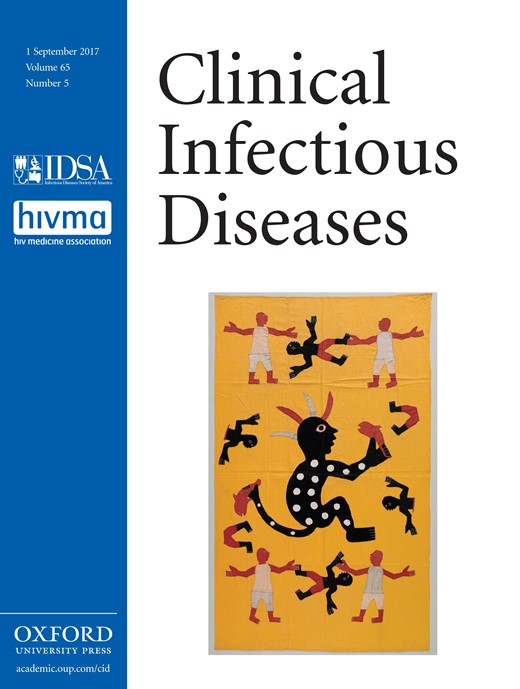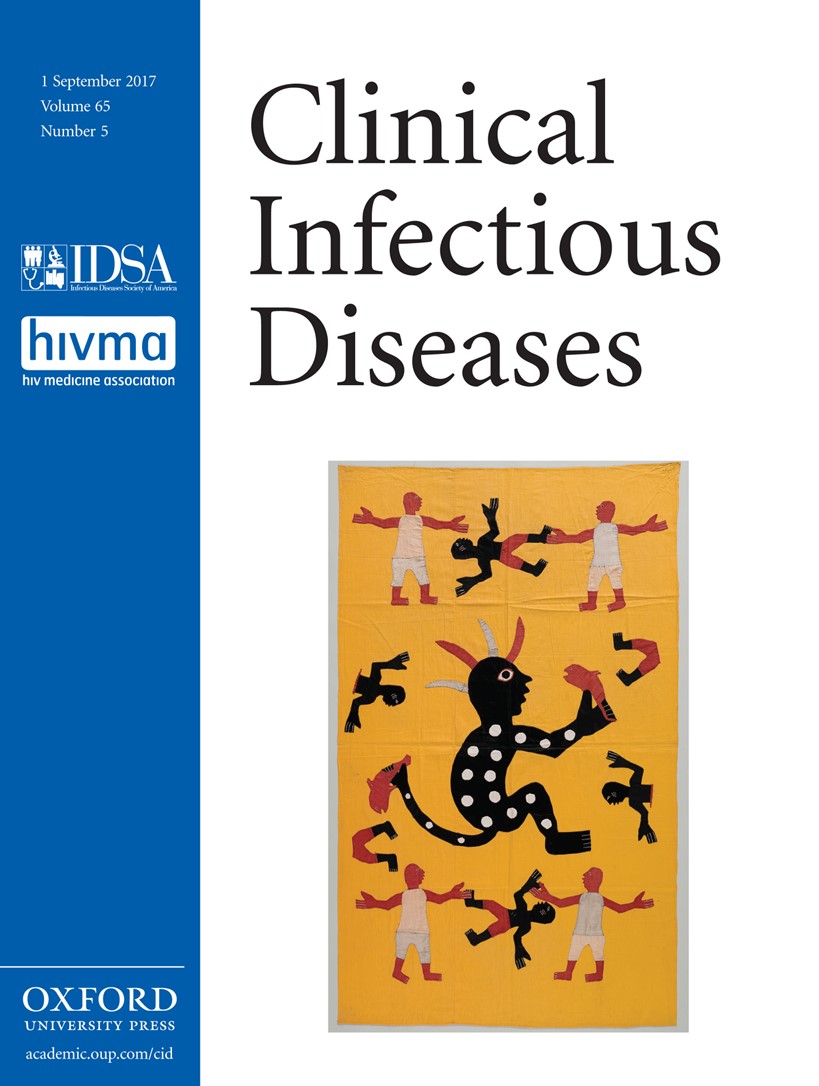
Cover image

Volume 65, Issue 5, 1 September 2017
NEWS
News
IN THE LITERATURE
In the Literature
ARTICLES AND COMMENTARIES
The National Academy Report on the Elimination of Viral Hepatitis: An Infectious Disease Physician’s Perspective
Hepatitis B and C viruses are leading causes of liver disease. The United States should engage in a coordinated effort to eliminate viral hepatitis as a public health problem, which requires special attention to populations often seen by infectious disease clinicians.
Incidence of Gonorrhea and Chlamydia Following Human Immunodeficiency Virus Preexposure Prophylaxis Among Men Who Have Sex With Men: A Modeling Study
Human immunodeficiency virus preexposure prophylaxis (PrEP) could lead to reductions in bacterial sexually transmitted infections (STIs) among men who have sex with men if clinicians fully implement the Center for Disease Control and Prevention’s STI screening recommendations for PrEP users.
Systematic Review and Meta-analysis of Indirect Protection Afforded by Vaccinating Children Against Seasonal Influenza: Implications for Policy
Our review of 30 studies found that influenza vaccination in children affords indirect protection to unimmunized persons of all ages in closely connected communities against laboratory-confirmed influenza, household members against illness compatible with influenza, and the elderly in wider communities against influenza-related mortality.
Risk of Nontargeted Infectious Disease Hospitalizations Among US Children Following Inactivated and Live Vaccines, 2005–2014
We found a significantly lower risk of nontargeted infectious disease hospitalizations for children aged 16 through 24 months if the last type of vaccine they received prior to hospitalization was live-only compared with receipt of inactivated-only vaccines.
Whole-Genome Sequencing Accurately Identifies Resistance to Extended-Spectrum β-Lactams for Major Gram-Negative Bacterial Pathogens
A whole-genome sequencing approach predicted phenotypic resistance to extended spectrum β-lactams for 4 leading causes of gram-negative bacteremia in neutropenic cancer patients at a level equal or superior to data generated in the clinical microbiology laboratory.
Distinct Helper T Cell Type 1 and 2 Responses Associated With Malaria Protection and Risk in RTS,S/AS01E Vaccinees
Vaccine-specific helper T-cell type 1 and 2 responses are associated with increased and decreased odds of clinical malaria, respectively, in children and infants vaccinated with the malaria vaccine RTS,S/AS01E in a phase 3 trial in Africa.
Increased Risk for Meningococcal Disease Among Men Who Have Sex With Men in the United States, 2012–2015
Although overall incidence is low, MSM are at increased risk of meningococcal disease compared to men not known to be MSM (non-MSM). HIV infection may play a key role in this increased risk.
Effect of Anthelmintic Treatment on Insulin Resistance: A Cluster-Randomized, Placebo-Controlled Trial in Indonesia
Anthelmintic treatment reduces soil-transmitted helminth prevalence, total IgE, and eosinophil count, but has no effect on insulin resistance (IR) at the community level. In helminth-infected subjects, treatment significantly increases IR, highlighting the need for careful metabolic health monitoring with deworming programs.
Impact of Fluoroquinolone Use on Mortality Among a Cohort of Patients With Suspected Drug-Resistant Tuberculosis
Among patients with suspected drug resistant tuberculosis, treatment with a later generation fluoroquinolone versus earlier generation or no fluoroquinolone significantly reduced mortality risk after adjusting for risk factors typically associated with poor outcomes.
Advanced Human Immunodeficiency Virus Disease in Botswana Following Successful Antiretroviral Therapy Rollout: Incidence of and Temporal Trends in Cryptococcal Meningitis
In a Botswana national meningitis survey, we observed a high 2013–2014 incidence of cryptococcal meningitis, particularly in men in their fourth or fifth decade, highlighting the need to target populations at high risk for advanced HIV and adopt differentiated care models.
Immunogenicity of the 13-Valent Pneumococcal Conjugate Vaccine in Older Adults With and Without Comorbidities in the Community-Acquired Pneumonia Immunization Trial in Adults (CAPiTA)
In immunocompetent adults ≥65 years of age, 13-valent pneumococcal conjugate vaccine elicits significant increases in opsonophagocytic activity titers and IgG concentrations. Responses were sustained for 2 years postvaccination for subjects in each age stratum and comorbidity group.
Patterns of Transmitted Drug Resistance and Virological Response to First-line Antiretroviral Treatment Among Human Immunodeficiency Virus–Infected People Who Use Illicit Drugs in a Canadian Setting
Between 1996 and 2015, prevalence of transmitted drug resistance (TDR) increased significantly among HIV-infected people who use drugs in Vancouver, mainly driven by increases in nonnucleoside reverse transcriptase inhibitor–related TDR, strongly supporting baseline resistance testing to guide antiretroviral selection.
Electronically Available Comorbidities Should Be Used in Surgical Site Infection Risk Adjustment
Centers for Disease Control and Prevention (CDC) surgical site infection (SSI) risk adjustment models do not adjust for patient comorbidities. We developed risk adjustment models using electronically-available comorbidities. The CDC should strongly consider adopting comorbidity-based risk adjustment.
Reduced Severity of Pertussis in Persons With Age-Appropriate Pertussis Vaccination—United States, 2010–2012
Analysis of US surveillance data demonstrates that both severe and clinically significant pertussis illnesses are less common among patients who have received age-appropriate vaccination for pertussis, demonstrating that the positive impact of pertussis vaccination extends beyond decreasing risk of disease.
Plasma Cytokine Predictors of Tuberculosis Recurrence in Antiretroviral-Treated Human Immunodeficiency Virus-infected Individuals from Durban, South Africa
Significantly higher plasma levels of IL6, IL1β, and sIL1Rα were associated with increased risk, whereas plasma IFNβ levels were associated with a decreased risk of TB recurrence in TB Recurrence upon Treatment with HAART (TRuTH) cohort, based in Durban, South Africa.
Population-Level Herd Protection of Males From a Female Human Papillomavirus Vaccination Program: Evidence from Australian Serosurveillance
Existing evidence of a male herd protection impact from female human papillomavirus (HPV) vaccination comes from genital-wart and HPV infection studies. This is the first evidence from population-level immunity changes supporting an indirect effect in males temporally associated with female vaccination.
Incidence of Norovirus-Associated Diarrhea and Vomiting Disease Among Children and Adults in a Community Cohort in the Peruvian Amazon Basin
This study provides population-based incidence of norovirus from a tropical region. We noted substantially higher rates in children aged <2 years. Inclusion of vomiting syndromes resulted in higher capture of norovirus cases. Norovirus rate among controls was similar to rates reported globally.
REVIEW ARTICLE
Effectiveness of Rotavirus Vaccination: A Systematic Review of the First Decade of Global Postlicensure Data, 2006–2016
The first decade of postlicensure data from 24 countries demonstrates that both globally recommended rotavirus vaccines are effective against severe rotavirus gastroenteritis across a range of mortality settings, supporting the World Health Organization recommendation for global use of rotavirus vaccines.



